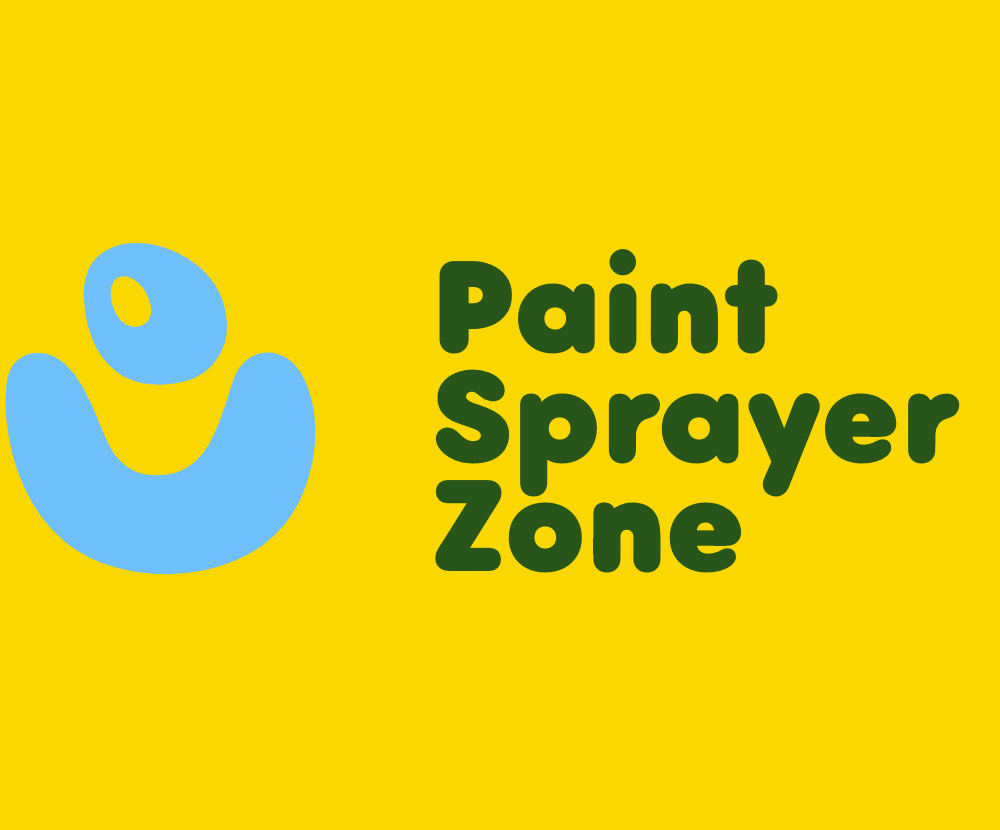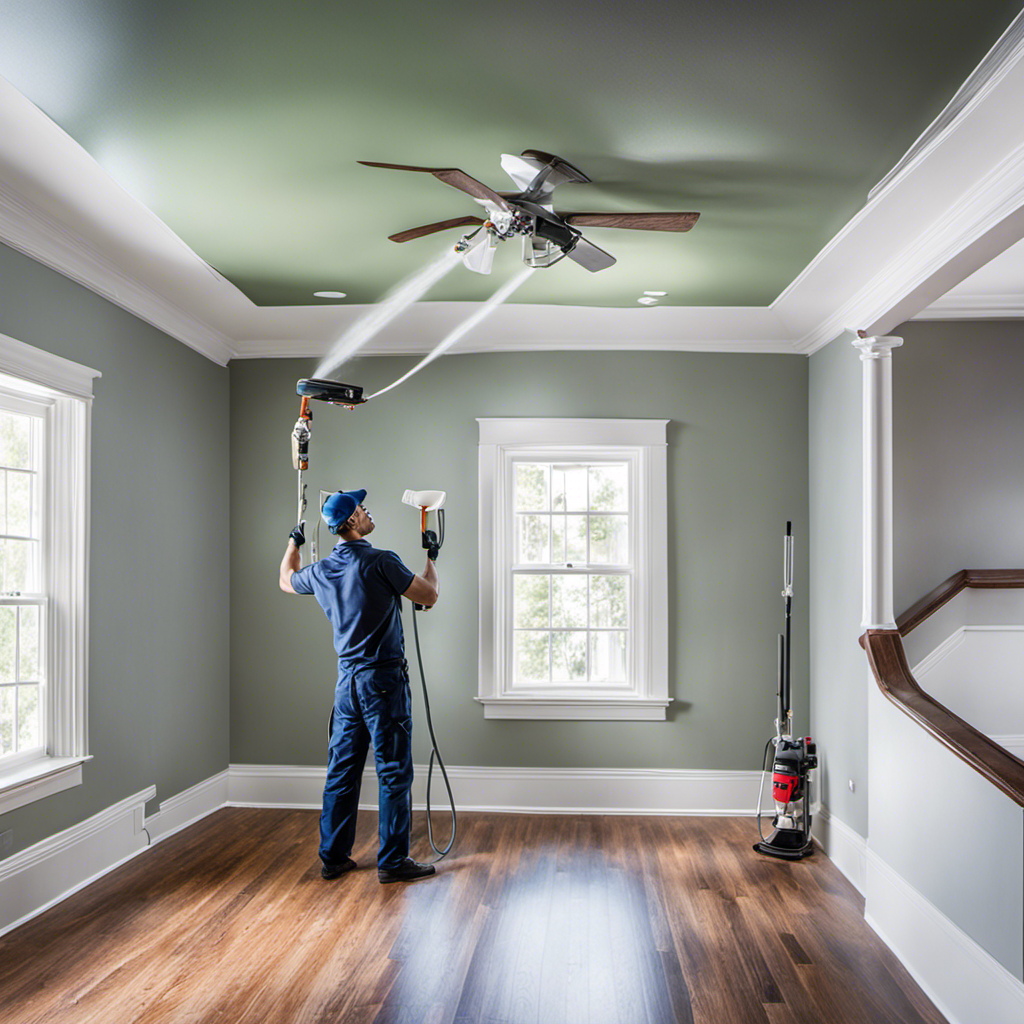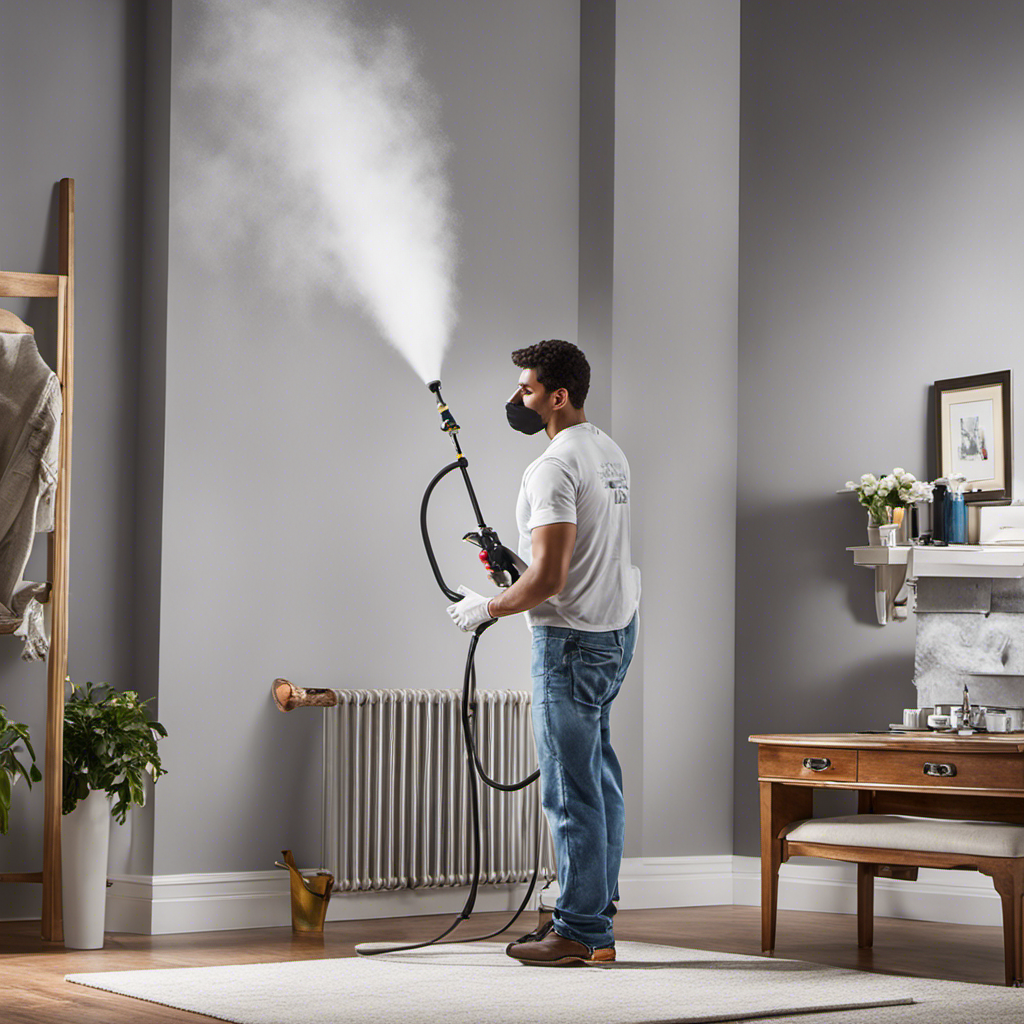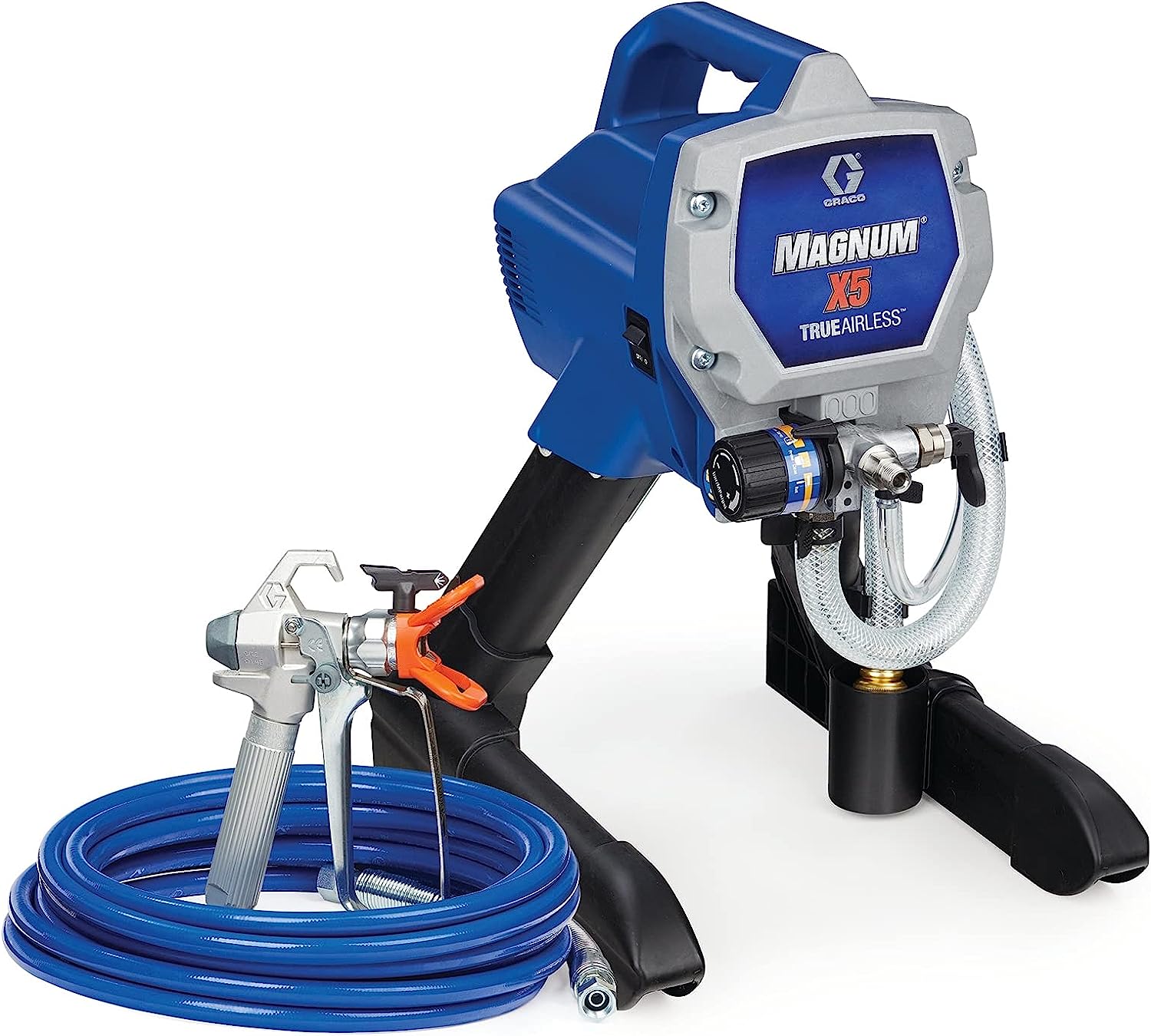Paint Sprayers FAQs
How to Spray Paint a Front Door With Airless Sprayer
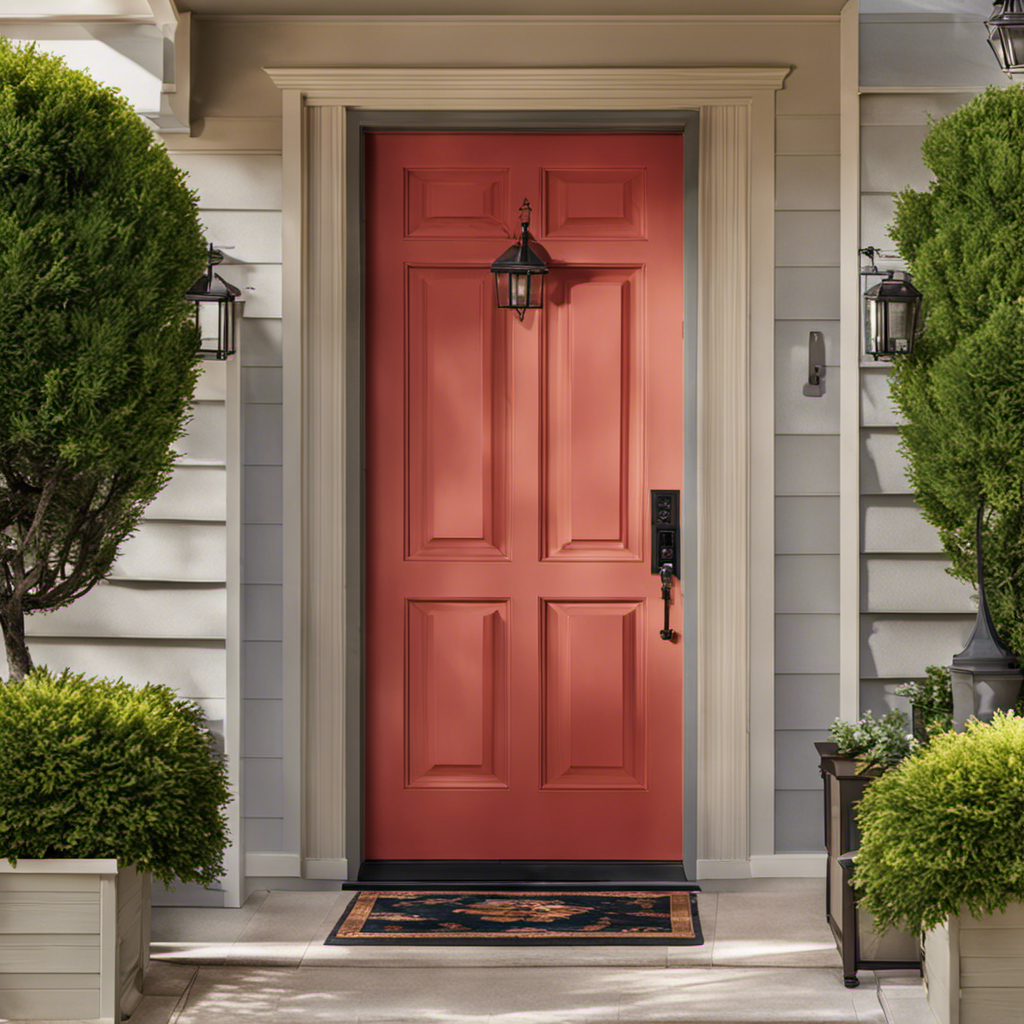
I have always been passionate about improving the appearance of my front door, and I have now found the ideal method: using an airless sprayer for spray painting.
In just a few simple steps, I’ll show you how to transform your front door into a stunning focal point for your home.
From selecting the right paint and equipment to preparing the surface and applying the perfect coat, I’ll guide you through each stage of the process.
Get ready to see your front door come to life like never before!
Key Takeaways
- Consider the overall aesthetic of your home and desired look when choosing paint colors for the front door.
- Compare different spray painting techniques, with airless sprayers being efficient and providing even coverage.
- Thoroughly clean the surface of the door using a mild detergent and water solution or a degreaser for stubborn stains.
- Select the right primer based on the material of the door and the type of paint being used.
Selecting the Right Paint and Equipment
You’ll want to make sure you’re using the appropriate type of paint and equipment for the job. When selecting paint colors for your front door, consider the overall aesthetic of your home and the desired look you want to achieve. Take into account the color scheme of your exterior and any architectural features you want to highlight.
Once you’ve chosen the perfect paint color, it’s time to compare different spray painting techniques. Airless sprayers are a popular option for front door painting due to their efficiency and even coverage. They provide a smooth finish and allow for quick application.
Now that you have your paint and equipment sorted, it’s time to move on to preparing the front door for painting, ensuring a professional-looking result.
Preparing the Front Door for Painting
When it comes to preparing the front door for painting, there are two key points that need to be considered: surface cleaning techniques and choosing the right primer.
First, it is important to thoroughly clean the surface of the door to ensure proper adhesion of the paint. This can be done by using a mild detergent and water solution, or by using a degreaser for more stubborn stains.
Once the surface is clean, it is crucial to select the right primer based on the material of the door and the type of paint being used. A primer helps to create a smooth and even surface for the paint to adhere to, ensuring a long-lasting and professional finish.
Surface Cleaning Techniques
To ensure proper adhesion, it’s important to thoroughly clean the surface before spray painting the front door with an airless sprayer. Surface preparation techniques play a crucial role in achieving a smooth and long-lasting finish.
The first step is to remove any dirt, dust, or grime from the door using a mild detergent and water. Scrub the surface gently with a soft brush or sponge, paying special attention to corners and crevices. Rinse thoroughly and allow the door to dry completely before proceeding.
It’s essential to remove any existing paint or varnish that may be peeling or flaking. Use a paint scraper or sandpaper to smooth out any rough spots. By taking the time to properly clean the surface, you’ll create the ideal foundation for a flawless paint job.
Now, let’s move on to choosing the right primer for your front door.
Choosing the Right Primer
Before deciding on a primer, it’s important to consider the type of surface and the desired finish for your front door. Surface preparation techniques are crucial for achieving a smooth and long-lasting paint job.
Using a primer before painting offers several benefits. Firstly, it helps to seal the surface and create a uniform base for the paint. This ensures better adhesion and prevents peeling or cracking in the future. Secondly, primer helps to block stains and hide imperfections, giving your front door a flawless appearance. Additionally, it promotes durability and protects the surface from moisture, UV rays, and other environmental factors.
Now that we understand the importance of choosing the right primer, let’s move on to the next step: cleaning and sanding the surface.
Cleaning and Sanding the Surface
When it comes to painting a front door, surface preparation is crucial for achieving a smooth and long-lasting finish. In order to ensure proper adhesion of the paint, it is important to thoroughly clean the door before starting the painting process.
Additionally, sanding the surface can help to smooth out imperfections and create a more even surface for the paint to adhere to. Here are some cleaning techniques and sanding tips and tricks that can help you achieve professional-looking results.
Surface Preparation Importance
Proper surface preparation is crucial for achieving a smooth and long-lasting spray paint finish on your front door. By taking the time to prepare the surface correctly, you can ensure that the paint adheres properly and that the final result is flawless. There are several surface preparation techniques that can be used, depending on the condition of your door. These techniques include cleaning the surface, repairing any damage, and sanding to create a smooth and even surface.
To emphasize the importance of proper surface preparation, consider the following table:
| Surface Preparation Techniques | Importance |
|---|---|
| Cleaning | Removes dirt, grease, and grime, allowing the paint to adhere properly |
| Repairing | Fixes any cracks, holes, or imperfections in the surface |
| Sanding | Creates a smooth and even surface for the paint to adhere to |
Cleaning Techniques for Door
Using a mild detergent and warm water is an effective way to clean the surface of your front door before applying the paint. When it comes to cleaning products, make sure to choose ones that are safe for the material of your door. Avoid using harsh chemicals or abrasive cleaners as they can damage the surface.
Start by mixing the detergent with warm water and using a soft sponge or cloth to gently scrub the door. Pay attention to any dirt, dust, or grime buildup, especially in crevices and corners. Rinse the door thoroughly with clean water and allow it to dry completely before proceeding to the next step of sanding tips and tricks.
Transition: Now that the door is clean and dry, it’s time to move on to the important step of sanding.
Sanding Tips and Tricks
Now that the door is clean and dry, it’s time for you to start sanding. Make sure to use a fine-grit sandpaper for a smooth and even surface. Here are some sanding techniques and tools that will help you achieve the best results:
- Start by sanding the entire surface of the door in a circular motion. This will help remove any imperfections and create a better adhesion for the paint.
- Pay extra attention to the edges and corners of the door, as these areas tend to have more buildup and require more sanding.
- Use sanding blocks or sanding sponges to keep the sandpaper flat against the surface and prevent uneven sanding.
- For hard-to-reach areas, such as intricate designs or panels, consider using a small detail sander or sanding attachments for your power tools.
By following these sanding techniques and using the right sanding tools, you will ensure a smooth and even surface for your paint application.
Now, let’s move on to repairing any damaged areas on the door.
Repairing Any Damaged Areas
To fix any damaged areas, you’ll need to start by sanding down the surface of the front door. This will ensure a smooth and even base for the repair work.
Begin by using medium-grit sandpaper to gently remove any loose paint or rough patches.
Next, examine the door for any cracks or holes. To repair damaged surfaces, use a wood filler or putty knife to fill in these areas. Apply the filler in thin layers, allowing each layer to dry before adding more. Once the filler is completely dry, sand it down to create a seamless finish.
By addressing and repairing these damaged areas, you’ll be able to achieve a flawless result when spray painting your front door.
Now, let’s move on to masking off the surrounding areas to protect them from overspray.
Masking Off Surrounding Areas
When it comes to masking off surrounding areas before spray painting, it is important to use proper taping techniques to ensure clean lines and prevent paint from bleeding through. This involves using high-quality painter’s tape and taking the time to carefully apply it along the edges of the surfaces you want to protect.
Additionally, protecting adjacent surfaces from overspray is crucial to avoid any unwanted paint splatters or damage, so it is recommended to use drop cloths or plastic sheets to cover furniture, floors, and other nearby objects.
Proper Taping Techniques
First, make sure you’re using painter’s tape to properly mask off any areas on your front door that you don’t want to be sprayed. Here are some tips to help you achieve a clean and professional finish:
- Start by applying the tape along the edges of the areas you want to protect, such as windows, hardware, and trim.
- Press the tape firmly to ensure good adhesion and prevent paint bleed.
- To minimize paint drips, make sure the tape is securely in place and covers the entire area you want to protect.
When spraying, keep the sprayer at a consistent distance from the door to avoid uneven coverage and potential drips. Once you’ve finished painting, carefully remove the tape while the paint is still wet to prevent it from sticking to the door and leaving residue.
By following these taping techniques, you can achieve a professional-looking paint job while minimizing paint drips and ensuring easy removal of tape residue.
Now, let’s move on to protecting adjacent surfaces without compromising the quality of your paint job.
Protecting Adjacent Surfaces
Make sure you’re using drop cloths to protect nearby floors and furniture from any potential overspray. This is an essential step in minimizing paint splatters and protecting your flooring. Here’s a table to help you choose the right type of drop cloth for your project:
| Type of Drop Cloth | Material | Features |
|---|---|---|
| Canvas | Heavy-duty fabric | Durable and reusable |
| Plastic | Polyethylene | Waterproof and lightweight |
| Paper | Kraft paper | Disposable and affordable |
When selecting a drop cloth, consider the size of your front door and the amount of space you need to cover. Covering any areas that could be affected by overspray will save you time and effort in cleaning up later. Now that you have protected your adjacent surfaces, let’s move on to minimizing the effects of overspray without compromising the quality of your paint job.
Minimizing Overspray Effects
To minimize the effects of overspray, it’s important to properly adjust the settings on your sprayer. Here are some techniques that can help in minimizing overspray and preventing paint drift:
-
Adjust the pressure: Lowering the pressure on your sprayer can help reduce overspray. Start with a lower pressure setting and gradually increase it until you achieve the desired coverage without excessive overspray.
-
Use a smaller spray tip: Using a smaller spray tip can also help in minimizing overspray. A smaller tip creates a narrower spray pattern, reducing the chances of paint drifting onto unintended surfaces.
By implementing these techniques, you can effectively minimize overspray and achieve a more precise and controlled painting process.
Now, let’s transition into the next section about setting up the airless sprayer.
Setting Up the Airless Sprayer
Once you’ve gathered all the necessary materials, it’s time to set up the airless sprayer for painting your front door.
Before starting, it’s crucial to understand the importance of surface preparation. A well-prepared surface ensures better adhesion and a smoother finish.
Begin by thoroughly cleaning the door using a mild detergent and water. Remove any dirt, grease, or old paint using a scrub brush or sponge. Rinse the door with clean water and allow it to dry completely.
Once the door is clean, assemble the airless sprayer according to the manufacturer’s instructions. This typically involves attaching the spray gun, hose, and ensuring the proper settings for pressure and spray pattern.
With the airless sprayer set up, you’re ready to move on to applying the primer coat, ensuring a solid foundation for the paint to adhere to.
Applying the Primer Coat
Before you begin applying the primer coat, ensure that the surface of the door is clean and dry. Surface preparation is of utmost importance to achieve a smooth and long-lasting finish. Here are a few key steps to follow:
-
Clean the surface: Use a mild detergent and water to remove any dirt, grease, or debris from the door. Rinse it thoroughly and let it dry completely.
-
Repair damaged areas: Inspect the door for any cracks, holes, or imperfections. Use a wood filler to repair these areas and sand them smooth once dry.
By properly preparing the surface, you create a solid foundation for the primer coat to adhere to and ensure better adhesion for the subsequent paint coat(s).
Now let’s move on to applying the paint coat(s) to complete the transformation of your front door.
Applying the Paint Coat(s
Now that the surface is properly prepared, you’re ready to start applying the paint coat(s) to your front door. To achieve a smooth finish, it’s important to use proper paint drying techniques.
Begin by applying a thin and even coat of paint, making sure to cover the entire surface. Start at the top and work your way down, using smooth, overlapping strokes.
Allow the first coat to dry completely before applying additional coats. This will prevent the paint from running or sagging. Depending on the type of paint you’re using, you may need to apply two or three coats for full coverage.
Once the final coat is applied, allow the paint to dry and cure according to the manufacturer’s instructions. This will ensure a durable and long-lasting finish.
In the next section, we will discuss the importance of drying and curing the paint for optimal results.
Drying and Curing the Paint
To achieve a durable and long-lasting finish, be sure to follow the manufacturer’s instructions for drying and curing the paint on your front door. Proper drying and curing are crucial in ensuring a professional-looking result. Here are some key points to keep in mind:
-
Allow sufficient drying time: The manufacturer’s instructions will provide guidance on how long the paint needs to dry between coats and before handling. Rushing this process can lead to smudges and imperfections.
-
Ensure proper ventilation: Adequate airflow is essential for the drying and curing process. Open windows or use fans to promote air circulation, helping the paint to dry evenly and reducing the risk of a sticky finish.
Cleaning and maintaining the airless sprayer is essential to prolong its lifespan and ensure optimal performance. Taking good care of your equipment will save you time and money in the long run, while also guaranteeing a smooth painting experience.
Cleaning and Maintaining the Airless Sprayer
It’s important to regularly clean and maintain your airless sprayer to ensure its longevity and optimal performance. One key area to focus on is cleaning the sprayer nozzle. Over time, paint residue can build up and clog the nozzle, leading to uneven spray patterns or even complete blockages.
To clean the nozzle, remove it from the sprayer and soak it in a cleaning solution. Use a small brush or toothpick to remove any stubborn residue.
Additionally, it’s crucial to troubleshoot common sprayer issues. For example, if the sprayer is not priming properly, check for any air leaks and ensure that all connections are tight. If the sprayer is not spraying evenly, check the nozzle for any clogs or obstructions.
Frequently Asked Questions
How Long Does It Take for the Primer Coat to Dry Before Applying the Paint Coat?
It typically takes about 1-2 hours for the primer coat to dry before applying the paint coat. It is important to use a paint that is compatible with an airless sprayer for the best results.
Can I Use Any Type of Paint for My Front Door, or Are There Specific Types That Work Better With an Airless Sprayer?
When using an airless sprayer, it’s important to choose the right type of paint. Certain paints, like latex or acrylic, work best with airless sprayers. Consider the viscosity and compatibility of the paint for optimal results.
How Do I Know if My Front Door Needs Any Repairs Before Painting?
Before painting, I always check my front door for any signs of damage. I go through a front door repair checklist that includes looking for cracks, rot, loose hinges, and peeling paint.
What Safety Precautions Should I Take When Using an Airless Sprayer?
To ensure safety when using an airless sprayer, it’s important to take precautions. Proper ventilation is key, as well as wearing protective goggles, gloves, and a mask. Always follow the manufacturer’s guidelines for safe operation.
Is It Necessary to Clean the Airless Sprayer After Every Use, or Can I Let the Paint Dry and Clean It Later?
I always clean my airless sprayer after every use. It’s important to prevent clogs and maintain its performance. Plus, the cleaning process is easy and quick, saving me time in the long run.
Conclusion
In conclusion, painting your front door with an airless sprayer is a quick and efficient way to give it a fresh new look. By following the steps outlined in this article, you can achieve professional-looking results.
Remember to choose the right paint and equipment, prepare the surface properly, and apply both the primer coat and paint coats evenly. Don’t forget to allow for drying and curing time, and make sure to clean and maintain your airless sprayer for future use.
Give your front door a makeover and make a bold statement with a beautifully painted finish.
Franz came aboard the Paint Sprayer Zone team with a background in both journalism and home renovation. His articulate writing style, combined with a passion for DIY projects, makes him an invaluable asset. Franz has a knack for breaking down technical jargon into easy-to-understand content, ensuring that even the most novice of readers can grasp the complexities of paint sprayers.
Paint Sprayers FAQs
How to Put Oil in Graco Airless Paint Sprayer
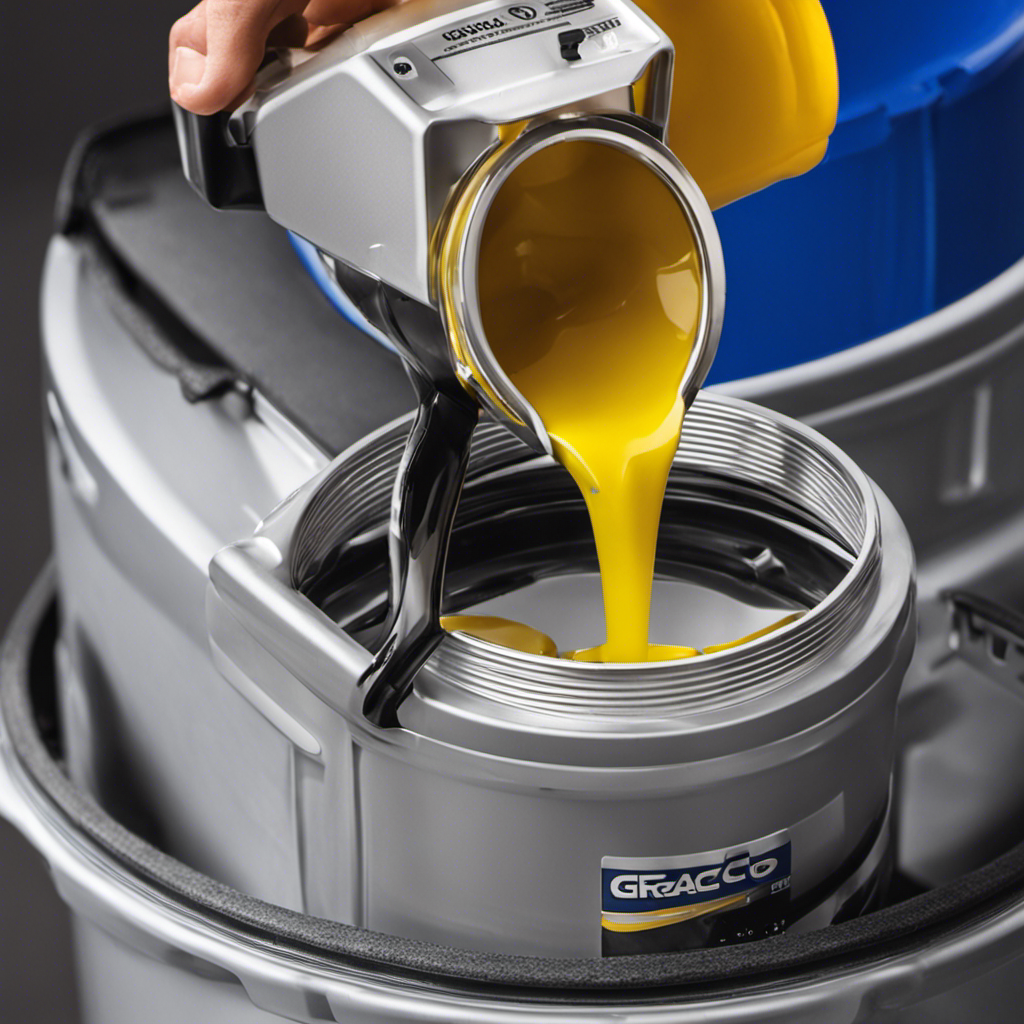
I found that 80% of the problems with Graco airless paint sprayers stem from low oil levels.
To keep your sprayer running smoothly and avoid costly repairs, it’s essential to know how to properly add oil.
In this article, I’ll guide you step-by-step through the process of adding oil to your Graco airless paint sprayer.
With the right tools, techniques, and maintenance tips, you can extend the lifespan of your sprayer and achieve professional-quality results every time.
Key Takeaways
- Oil lubricates internal components, reducing friction and wear.
- Proper oil maintenance prevents rust and corrosion.
- Maintaining the right oil level ensures consistent performance.
- Using the recommended oil type ensures optimal operation.
Understanding the Importance of Oil in Your Graco Airless Paint Sprayer
Understanding the importance of oil in your Graco airless paint sprayer is crucial for proper maintenance and optimal performance. Choosing the right type of oil is essential to ensure that your paint sprayer operates smoothly and efficiently. Graco recommends using a high-quality, non-detergent oil specifically designed for airless sprayers.
Regularly maintaining the oil in your paint sprayer offers several benefits. Firstly, it helps to lubricate the internal components, reducing friction and wear. This prolongs the lifespan of your sprayer and ensures consistent performance. Secondly, proper oil maintenance helps to prevent rust and corrosion, keeping your equipment in excellent condition. Lastly, maintaining the right oil level ensures that your paint sprayer operates at its best, delivering a consistent spray pattern and reliable results.
Now, let’s move on to the tools and supplies needed for adding oil to your Graco airless paint sprayer.
Tools and Supplies Needed for Adding Oil to Your Graco Airless Paint Sprayer
To add oil to your Graco airless paint sprayer, you’ll need a few tools and supplies.
First, you will need a small funnel to ensure that the oil goes into the right place without any spills or mess.
Additionally, having a clean cloth or rag is crucial to wipe away any excess oil and keep your sprayer in pristine condition.
As for supplies, you will need a high-quality lubricating oil that is specifically designed for airless paint sprayers. It’s important to use the right type of oil to ensure optimal performance and longevity of your equipment.
Once the oil is added, you can move on to the next step in the process, which involves preparing your paint sprayer for oil application by following a step-by-step guide.
Step-by-Step Guide: Preparing Your Paint Sprayer for Oil Application
First, make sure you have all the necessary tools and supplies ready for preparing your paint sprayer for oil application.
The oil application process is an important part of regular maintenance for your graco airless paint sprayer.
To begin, turn off the sprayer and unplug it from the power source.
Next, remove the spray tip and guard, followed by the prime valve and suction tube.
Inspect these parts for any signs of damage or wear, and replace if necessary.
Clean the parts thoroughly with a brush and solvent, ensuring all paint residue is removed.
Once cleaned, lubricate the parts with a few drops of oil, making sure to distribute it evenly.
Locating the Oil Fill Port in Your Graco Airless Paint Sprayer
When it comes to maintaining and operating a Graco airless paint sprayer, knowing the location of the oil fill port is crucial. The oil fill port is typically located on the top or side of the sprayer, near the pump assembly.
To ensure easy access for oil filling, it is important to familiarize yourself with the specific model of your sprayer and its oil fill port location.
Oil Fill Port Location
The oil fill port is typically located near the top of the Graco airless paint sprayer. It serves as the entry point for adding oil to the machine, ensuring smooth operation and longevity.
Proper maintenance of the oil fill port is essential to prevent clogs and ensure optimal performance. To maintain the oil fill port, it is recommended to clean it regularly using a soft brush or cloth to remove any debris or residue.
Additionally, a small amount of lubricating oil can be applied to the port to keep it lubricated and prevent rust or corrosion.
Easy Oil Filling Process
To easily fill your machine with oil, all you need to do is locate the oil fill port and gently pour the oil into it.
Here are some easy oil maintenance and oil application tips for your Graco airless paint sprayer:
-
Use the correct oil: It is important to use the oil recommended by Graco for your specific model. Using the wrong oil can cause damage to the machine.
-
Check the oil level regularly: Before each use, check the oil level to ensure it is at the recommended level. If the oil is low, add more to prevent damage to the pump.
-
Use a funnel: When pouring the oil into the fill port, use a funnel to prevent spills and ensure accurate pouring.
-
Clean the oil fill port: Before adding new oil, make sure the fill port is clean and free from any debris or contaminants.
By following these easy oil maintenance and application tips, you can ensure the smooth operation and longevity of your Graco airless paint sprayer.
Now let’s move on to choosing the right type of oil for your machine.
Choosing the Right Type of Oil for Your Graco Airless Paint Sprayer
You should consider which type of oil is right for your Graco Airless Paint Sprayer. Choosing the right oil viscosity and understanding oil additives are key factors in ensuring optimal performance and longevity of your sprayer. The table below provides a guide to help you select the appropriate oil for your specific needs.
| Oil Viscosity | Recommended Usage | Oil Additives |
|---|---|---|
| Low | Cold weather | Anti-wear |
| Medium | General use | Rust inhibitors |
| High | Hot weather | Detergents |
When selecting the oil viscosity, take into account the temperature conditions in which you will be using the sprayer. Additionally, consider any specific additives that may enhance the performance or protect against certain issues. Now that you have chosen the right oil for your Graco Airless Paint Sprayer, let’s discuss the proper techniques for adding oil without compromising the functionality of your sprayer.
Proper Techniques for Adding Oil to Your Graco Airless Paint Sprayer
Before adding oil to your Graco Airless Paint Sprayer, it’s important to know the proper techniques to ensure optimal functionality. Here are four common mistakes to avoid and the proper techniques to follow:
-
Using the wrong type of oil: Make sure to use the recommended oil specified in the user manual to prevent damage to your sprayer.
-
Overfilling the oil reservoir: Only fill the reservoir up to the designated level to avoid oil leakage or pressure issues.
-
Neglecting to clean the oil filler cap: Before adding oil, clean the filler cap to prevent dirt or debris from contaminating the oil.
-
Not checking the oil level regularly: It’s important to regularly check the oil level and top it up when necessary to maintain proper lubrication and prevent damage to the sprayer.
By following these proper techniques, you can ensure that your Graco Airless Paint Sprayer operates smoothly and efficiently.
Now let’s move on to how to check and maintain the oil level in your sprayer…
How to Check and Maintain the Oil Level in Your Graco Airless Paint Sprayer
Now, let’s focus on checking and maintaining the oil level in your Graco sprayer. Proper oil maintenance is crucial for the optimal performance and longevity of your airless paint sprayer.
To ensure the oil level is adequate, follow these steps:
-
Start by locating the oil level indicator on your Graco sprayer. It is usually located near the pump assembly.
-
Check the oil level by referring to the indicator. It should be within the recommended range, typically marked as ‘Full’ or ‘Add.’
-
If the oil level is low, add the appropriate amount of oil recommended by the manufacturer. Use a funnel to avoid spills.
By regularly checking and maintaining the oil level, you can prevent damage to the pump and ensure smooth operation of your Graco airless paint sprayer.
Moving on to tips and tricks for extending the lifespan of your Graco airless paint sprayer with regular oil maintenance…
Tips and Tricks for Extending the Lifespan of Your Graco Airless Paint Sprayer With Regular Oil Maintenance
To maximize the lifespan of your Graco sprayer and keep it running smoothly, remember to regularly maintain the oil level as recommended. Here are some tips and tricks for extending the lifespan of your Graco airless paint sprayer through regular oil maintenance:
-
Follow the manufacturer’s guidelines: Graco provides specific instructions for oil maintenance, including the type of oil to use and the recommended intervals for oil changes. Adhering to these guidelines will ensure optimal performance and longevity.
-
Check the oil level regularly: It’s important to monitor the oil level in your sprayer to prevent damage from running it with insufficient lubrication. Make it a habit to check the oil level before each use and top it up if necessary.
-
Use high-quality oil: Using the right type of oil is crucial for ensuring proper lubrication. Graco recommends using their own brand of oil or a high-quality equivalent that meets their specifications.
-
Keep the oil clean: Contaminated oil can negatively impact the performance of your sprayer and cause premature wear and tear. Regularly check for any debris or particles in the oil and replace it if necessary.
By following these maintenance tips, you can extend the lifespan of your Graco airless paint sprayer and keep it operating at its best.
Now, let’s dive into troubleshooting common issues when adding oil to your Graco airless paint sprayer.
Troubleshooting Common Issues When Adding Oil to Your Graco Airless Paint Sprayer
One common issue when adding oil to your Graco sprayer is an incorrect oil level. It is important to ensure that the oil level is at the appropriate level to avoid any potential problems with your sprayer. To help you troubleshoot this issue and understand the best practices for adding oil to your Graco airless paint sprayer, I have created a table below:
| Troubleshooting Issue | Possible Cause | Best Practice |
|---|---|---|
| Incorrect oil level | Overfilling or underfilling the oil reservoir | Check the owner’s manual for the correct oil level and fill accordingly |
| Oil leakage | Loose or damaged oil cap or seal | Inspect the oil cap and seal for any damage or looseness, and replace if necessary |
| Oil contamination | Mixing different types of oil or using old oil | Use only the recommended oil and replace it regularly to avoid contamination |
Frequently Asked Questions
Can I Use Any Type of Oil in My Graco Airless Paint Sprayer?
Yes, you can use different types of oil suitable for Graco airless paint sprayers. Proper oil maintenance is crucial for optimal performance. Follow the manufacturer’s guidelines to ensure you are using the correct oil.
How Often Should I Check the Oil Level in My Paint Sprayer?
I check the oil level in my paint sprayer regularly to ensure proper maintenance. It’s important to follow the recommended checking frequency to prevent any issues with the equipment.
Can I Overfill the Oil in My Graco Airless Paint Sprayer?
Yes, you can use too much oil in your Graco airless paint sprayer. Overfilling can lead to excessive lubrication, which can cause the equipment to malfunction and potentially damage the internal components.
What Should I Do if I Accidentally Spill Oil on My Paint Sprayer?
If I accidentally spill oil on my paint sprayer, I would immediately clean it to prevent any damage. I would carefully wipe off the excess oil, use a mild detergent to remove any residue, and ensure proper maintenance to avoid future spills.
Can I Use a Different Brand of Oil in My Graco Airless Paint Sprayer?
Yes, you can use a different brand of oil in your Graco airless paint sprayer. However, it is important to ensure oil compatibility with the sprayer to avoid any damage or malfunction.
Conclusion
In conclusion, adding oil to your Graco Airless Paint Sprayer is a crucial step in maintaining its performance and longevity.
Just like a well-oiled machine, your paint sprayer needs proper lubrication to function smoothly.
By following the step-by-step guide and using the right type of oil, you can ensure that your sprayer operates at its best.
Remember to regularly check and maintain the oil level to avoid any issues.
With proper oil maintenance, your Graco Airless Paint Sprayer will continue to deliver flawless results, just like a finely tuned engine.
Franz came aboard the Paint Sprayer Zone team with a background in both journalism and home renovation. His articulate writing style, combined with a passion for DIY projects, makes him an invaluable asset. Franz has a knack for breaking down technical jargon into easy-to-understand content, ensuring that even the most novice of readers can grasp the complexities of paint sprayers.
Paint Sprayers FAQs
When to Replace the Filters in Airless Paint Sprayer
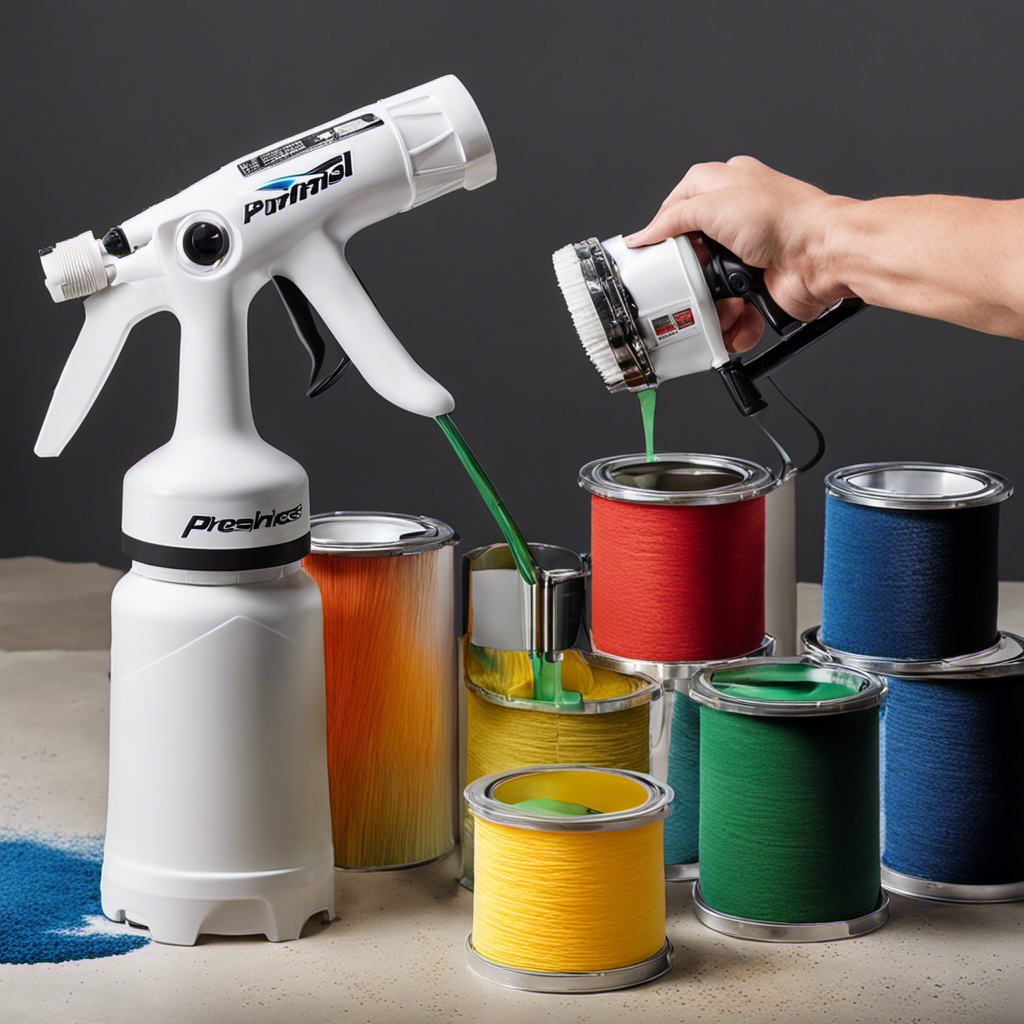
When it comes to maintaining an airless paint sprayer, one crucial point to emphasize is the regular replacement of filters. This practice greatly enhances the machine’s performance and longevity.
As a professional painter, I understand the importance of keeping the filters in optimal condition. In this article, we will explore the signs that indicate it’s time to replace the filters, how often they should be replaced, and the different types of filters available.
Additionally, I will share tips for proper maintenance and common mistakes to avoid.
Let’s dive in and ensure your airless paint sprayer stays in top shape!
Key Takeaways
- Regularly replacing filters improves performance and lifespan of airless paint sprayer.
- Signs that your filters need to be replaced include uneven spray patterns, clogging in the spray tip, decreased paint flow, and excessive pressure build-up.
- Filters should be replaced regularly for optimal performance, and the manufacturer’s recommended replacement schedule should be followed.
- Understanding the different types of filters and choosing the right one for your needs is important for optimal performance and longevity.
Importance of Regular Filter Replacement
You should regularly replace the filters in your airless paint sprayer because it ensures optimal performance and prevents clogs.
Filter maintenance techniques are crucial for the smooth operation of your paint sprayer. Clean filters play a vital role in maintaining the quality of your paint finish and preventing potential issues.
When the filters are clogged with dirt, debris, or dried paint particles, it can lead to uneven spray patterns, reduced pressure, and even damage to the paint sprayer.
By regularly replacing the filters, you can ensure that your airless paint sprayer operates at its full potential, providing consistent and high-quality results.
Now, let’s explore the signs that your filters need to be replaced, so you can avoid any potential problems down the line.
Signs That Your Filters Need to Be Replaced
If the spray from your machine becomes uneven or clogged, it’s a sign that it’s time to swap out those filters. Regular maintenance of airless paint sprayer filters is crucial for optimal performance and longevity of your equipment. Proper filter care offers several benefits, including improved spray quality, reduced downtime, and extended lifespan of the sprayer. Neglecting filter replacement can lead to costly repairs and diminished productivity.
To determine when filters need to be replaced, it’s important to be aware of the signs indicating their deterioration. Here are some common indicators that your filters are due for a change:
| Signs of Filter Replacement |
|---|
| Uneven spray pattern |
| Clogging in the spray tip |
| Decreased paint flow |
| Excessive pressure build-up |
| Reduced performance |
If you notice any of these signs, it’s time to replace your filters to ensure optimal performance. But how often should filters be replaced? Let’s explore this in the next section.
How Often Should Filters Be Replaced
In this discussion, I will address the key points of filter replacement frequency and signs of filter deterioration.
As the user of an airless paint sprayer, it’s important to understand how often filters should be replaced to ensure optimal performance.
Additionally, being able to identify signs of filter deterioration will help you maintain the efficiency and effectiveness of your paint sprayer.
Filter Replacement Frequency
The filter should be replaced regularly to ensure optimal performance of the airless paint sprayer. Maintaining a proper filter replacement schedule is crucial for the longevity and efficiency of the equipment. Here are some best practices for filter maintenance:
-
Regular Inspection:
-
Check the condition of the filter before every use.
-
Look for any signs of clogging or damage.
-
Timely Replacement:
-
Replace the filter based on the manufacturer’s recommended schedule.
-
Consider replacing it more frequently if you work with thick or heavily pigmented paints.
By adhering to a regular filter replacement schedule and following these best practices, you can ensure that your airless paint sprayer operates at its best. Neglecting filter maintenance can result in poor performance and potential damage to the sprayer.
Now, let’s explore the signs of filter deterioration and how to address them.
Signs of Filter Deterioration
Regularly inspecting the filter and looking for signs of clogging or damage helps ensure optimal performance of your equipment. Proper filter maintenance is crucial to extend its lifespan and maintain the efficiency of your airless paint sprayer. One of the first signs of filter deterioration is a decrease in paint flow or pressure. If you notice that the spray pattern is uneven or the paint is not being evenly distributed, it may be a sign that the filter is clogged or damaged.
Additionally, inspect the filter for any visible signs of wear or tear, such as cracks or holes. If you see any of these signs, it is important to replace the filter as soon as possible to avoid further damage to your equipment.
Understanding the different types of filters is the next step in maintaining your airless paint sprayer.
Understanding the Different Types of Filters
You’ll need to familiarize yourself with the different types of filters used in airless paint sprayers. Choosing the right filter for your paint sprayer is crucial in ensuring optimal performance and longevity. There are various types of filter materials available, each with its own unique characteristics and benefits.
Here are two sub-lists to help you understand the different types of filters:
-
Mesh Filters
-
Made from woven wire mesh
-
Ideal for removing larger particles and debris from the paint
-
Paper Filters
-
Made from cellulose or synthetic fibers
-
Offers superior filtration, capturing even the smallest particles
Now that you know the types of filter materials, you can make an informed decision when selecting the right filter for your paint sprayer. It’s important to consider factors such as the type of paint you’ll be using and the desired finish. By choosing the appropriate filter, you can achieve optimal spray pattern and minimize clogs.
Understanding the different types of filters is the first step in ensuring efficient painting results. Next, let’s explore the factors that affect filter lifespan.
Factors That Affect Filter Lifespan
When it comes to the lifespan of filters in an airless paint sprayer, two key factors play a crucial role: usage frequency and duration, as well as the type of paint used.
The more often and longer the sprayer is used, the quicker the filters may become clogged or worn out.
Additionally, different types of paint can have varying levels of viscosity and particulate matter, which can impact the lifespan of the filters.
Usage Frequency and Duration
To ensure optimal performance, it’s important to keep track of how often and for how long you use your airless paint sprayer. Here are some usage tips to help you get the most out of your equipment and avoid common mistakes:
- Use the sprayer on a regular basis to prevent the paint from drying and clogging the system.
- Be mindful of the duration of each painting session. Prolonged use can strain the motor and lead to overheating.
By following these usage tips, you can maximize the lifespan of your airless paint sprayer and minimize the need for repairs or replacements.
Now, let’s move on to the next section, where we will discuss the impact of the type of paint used on the performance of your sprayer.
Type of Paint Used
Using the wrong type of paint can negatively affect the performance and functionality of your airless paint sprayer. It is crucial to understand the impact of paint viscosity on the sprayer’s operation.
Different paint finishes have varying viscosity levels, which can determine the compatibility with your airless paint sprayer. High-viscosity paints, such as textured or elastomeric coatings, require a sprayer with a larger pump size and higher pressure capabilities. On the other hand, low-viscosity paints, like stains or lacquers, work well with smaller pumps and lower pressure settings.
Using the wrong viscosity can lead to clogs, uneven spray patterns, and reduced efficiency. Therefore, it is essential to choose the appropriate paint viscosity for your airless paint sprayer to ensure optimal performance.
Transitioning into the next section about ‘diy filter replacement vs. professional maintenance,’ it is crucial to maintain the sprayer’s filters to prevent paint debris from clogging the system.
DIY Filter Replacement Vs. Professional Maintenance
You should consider whether to replace the filters in your airless paint sprayer yourself or hire a professional for maintenance. Here are some points to help you make an informed decision:
-
DIY Filter Replacement:
-
Cost effective: Doing it yourself can save you money on labor costs.
-
Convenience: You can replace the filters at your own pace without relying on someone else’s schedule.
-
Professional Maintenance:
-
Expertise: Professionals have the knowledge and experience to properly replace filters and ensure optimal performance.
-
Warranty protection: Hiring a professional may be necessary to maintain your warranty coverage.
Considering the DIY vs professional approach for filter replacement is crucial for cost-effective maintenance. However, keep in mind that proper maintenance extends beyond filter replacement. It involves regular cleaning and inspection to ensure the filters are functioning efficiently.
Tips for Properly Maintaining Filters
When it comes to maintaining filters for airless paint sprayers, it’s important to understand the frequency at which they should be replaced. Regularly replacing filters ensures optimal performance and prevents clogs or damage to the sprayer.
However, before replacing a filter, it’s worth considering whether cleaning it might be a viable option, as this can help extend its lifespan and save on replacement costs.
Filter Replacement Frequency
The filter’s replacement frequency depends on how frequently you use the airless paint sprayer. If you use it frequently, you may need to replace the filter more often to maintain optimal performance. Regular cleaning is important to ensure that the filter is free from clogs and debris, but there are also benefits to using high-quality filters.
Here are two key points to consider:
-
Regular cleaning: Cleaning the filter regularly helps to remove accumulated paint particles and other contaminants, preventing them from clogging the spray tip. This ensures a smooth and consistent paint application, reducing the risk of uneven coverage or clogged spray patterns.
-
Benefits of high-quality filters: Investing in high-quality filters can significantly improve the performance and efficiency of your airless paint sprayer. These filters are designed to capture even the smallest particles, ensuring a clean and uninterrupted flow of paint. They also tend to have a longer lifespan, reducing the frequency of filter replacements and saving you time and money.
Considering these factors, it is important to find the right balance between cleaning and replacing filters to maintain optimal performance and avoid unnecessary expenses.
Cleaning Vs. Replacing
Now that we have discussed the frequency of filter replacement, let’s delve into the topic of cleaning versus replacing the filters in your airless paint sprayer.
While it is important to replace filters when they become excessively dirty or damaged, there are instances where you can extend their lifespan through proper maintenance. DIY cleaning is a cost-effective option that can help remove debris and prolong the filter’s effectiveness.
Regular filter maintenance involves removing the filter, gently rinsing it with water or a mild detergent, and allowing it to dry completely before reinserting it into the sprayer. However, it is crucial to note that cleaning can only go so far, and eventually, you will need to replace the filter to ensure optimal performance.
Transitioning into the subsequent section, let’s explore some effective ways to extend the lifespan of your filters.
Extending the Lifespan of Your Filters
To extend the lifespan of your filters, you should regularly clean and maintain them. Here are some tips for filter maintenance that can help you save money and ensure optimal performance:
- Clean the filters regularly by removing any debris or dust particles that may have accumulated on the surface.
- Use compressed air or a soft brush to gently clean the filters without damaging them.
- Replace the filters when they become clogged or damaged beyond repair.
- Consider using cost-effective filter replacement options, such as reusable filters or aftermarket filters that are compatible with your airless paint sprayer.
By following these maintenance tips, you can maximize the lifespan of your filters and avoid unnecessary expenses.
Now let’s move on to the next section and discuss some common mistakes to avoid when replacing filters.
Common Mistakes to Avoid When Replacing Filters
When replacing filters, it’s important to avoid common mistakes that can lead to inefficiency and potential damage. Proper filter maintenance is crucial for the optimal performance of airless paint sprayers. Here are some DIY filter replacement tips to ensure you get the most out of your equipment:
| Common Mistakes | Tips to Avoid Them |
|---|---|
| Not replacing filters regularly | Replace filters according to the manufacturer’s recommendations. Neglecting to do so can result in reduced efficiency and clogging. |
| Incorrect installation | Follow the instructions provided by the manufacturer to ensure proper installation. Improperly installed filters can lead to leaks and decreased performance. |
| Using the wrong type of filter | Always use filters specifically designed for your airless paint sprayer. Using the wrong filter can lead to poor filtration and potential damage to the equipment. |
| Not cleaning the filters before replacement | Clean the filters thoroughly before installing new ones. This helps maximize their lifespan and ensures efficient performance. |
Benefits of Timely Filter Replacement
By timely replacing your filters, you can experience the benefits of improved efficiency and extended equipment lifespan. Regular maintenance is crucial for optimal performance of your airless paint sprayer. Here are the benefits you can expect:
-
Improved Efficiency:
-
Clean filters allow for better airflow, ensuring consistent paint flow and reducing clogs.
-
Increased efficiency means less time wasted on troubleshooting and cleaning, resulting in more productive painting sessions.
-
Extended Equipment Lifespan:
-
Clogged filters strain the motor and other internal components, leading to premature wear and tear.
-
By replacing filters regularly, you can prevent costly repairs and prolong the life of your airless paint sprayer.
To ensure maximum effectiveness, proper filter storage is essential:
- Store filters in a clean, dry place to prevent dust and moisture buildup.
- Avoid exposing filters to extreme temperatures or direct sunlight, as this can degrade their performance.
Frequently Asked Questions
Can I Clean and Reuse Airless Paint Sprayer Filters Instead of Replacing Them?
Yes, you can clean and reuse airless paint sprayer filters instead of replacing them, but there are pros and cons. Cleaning can save money, but reused filters may not perform as well as new ones and could lead to clogs or uneven spray patterns.
How Can I Tell if My Filters Are Clogged and Need to Be Replaced?
Regular filter maintenance is crucial to ensure optimal performance. Signs of clogged filters include reduced paint flow, uneven spray pattern, and increased pressure. If these symptoms persist after cleaning, it may be time to replace the filters.
Are There Any Specific Types of Filters That Are More Durable and Have a Longer Lifespan?
Most durable filters for airless paint sprayers are made of high-quality materials like stainless steel or nylon. These filters have a longer lifespan and can withstand the demands of paint spraying applications.
Can I Use Non-Branded or Generic Filters for My Airless Paint Sprayer?
I can use non-branded filters for my airless paint sprayer, but there are pros and cons. It’s important to choose the right filter based on the specific needs of the paint sprayer to ensure optimal performance and longevity.
Should I Hire a Professional to Replace My Filters or Can I Do It Myself?
I can save money by replacing the filters in my airless paint sprayer myself instead of hiring professionals. It’s a simple task that requires minimal effort and can be done regularly for optimal performance.
Conclusion
In conclusion, regular filter replacement is crucial for maintaining the efficiency and longevity of your airless paint sprayer. By recognizing the signs of worn-out filters and understanding the different types available, you can ensure optimal performance.
Proper maintenance and avoiding common mistakes will help extend the lifespan of your filters, saving you time and money in the long run.
So, why wait for clogged filters to hinder your painting project? Take action now and enjoy smooth and flawless results.
Franz came aboard the Paint Sprayer Zone team with a background in both journalism and home renovation. His articulate writing style, combined with a passion for DIY projects, makes him an invaluable asset. Franz has a knack for breaking down technical jargon into easy-to-understand content, ensuring that even the most novice of readers can grasp the complexities of paint sprayers.
Paint Sprayers FAQs
How to Prepare Paint for Airless Sprayer
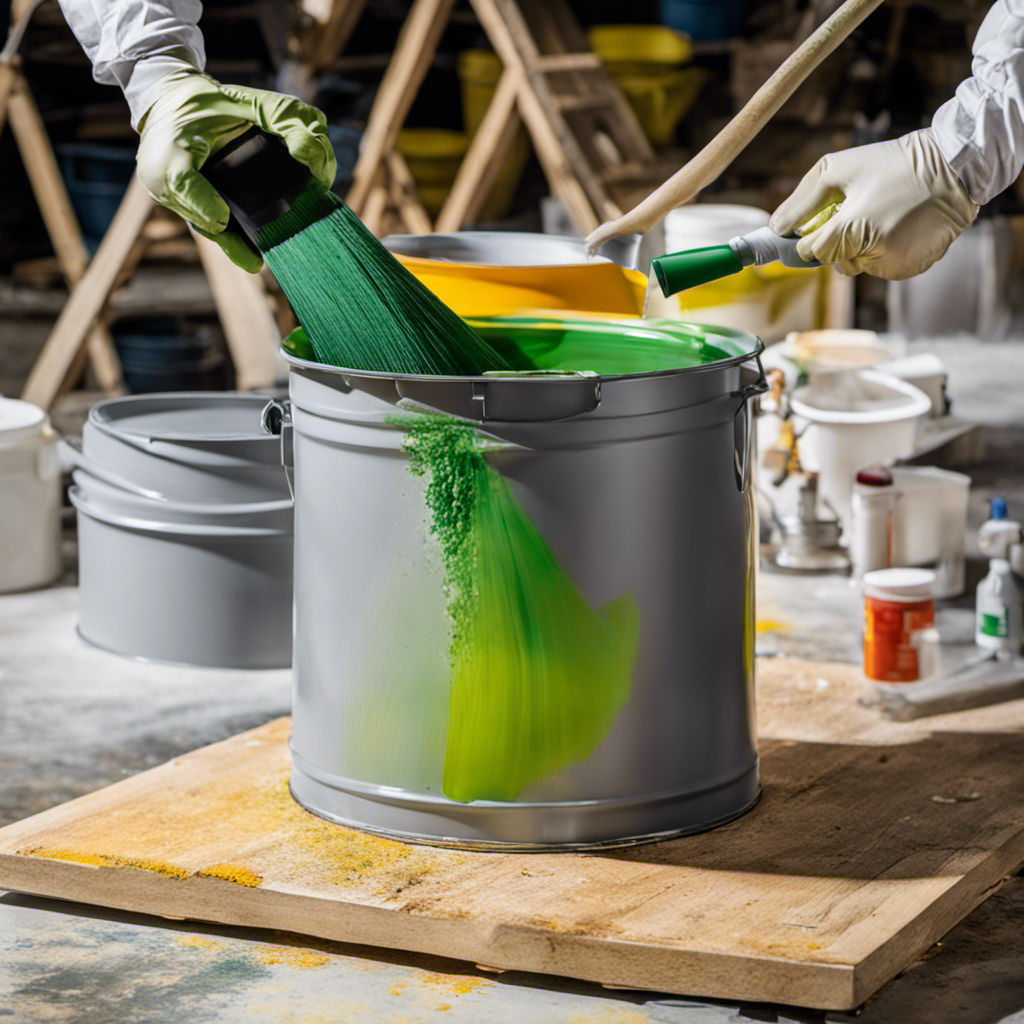
In all of my painting projects, my main objective has always been to achieve a perfect result. This has driven me to become skilled in preparing paint for use in an airless sprayer.
In this article, I’ll share my knowledge and expertise on selecting the right paint, preparing it for the sprayer, and setting up the equipment.
I’ll also provide techniques for achieving a smooth paint application and tips for cleaning and maintaining the airless sprayer equipment.
Get ready to elevate your painting game with these precise and detailed steps.
Key Takeaways
- Consider the viscosity and consistency of the paint for smooth flow and even application.
- Proper mixing techniques ensure thorough blending and avoid clumps.
- Filtering the paint removes impurities that can clog the sprayer nozzle.
- Viscosity affects atomization and spray quality, while consistency ensures even coverage and professional-looking results.
Understanding the Airless Sprayer System
Before you can use an airless sprayer, it’s important to understand how the system works. The airless sprayer is a powerful tool that uses high pressure to atomize paint and create a fine mist for smooth and even application.
To ensure the optimal performance of the airless sprayer, regular maintenance is crucial. This includes cleaning the filters, lubricating the pump, and inspecting the hoses for any signs of wear or damage. Troubleshooting common issues such as clogs or uneven spray patterns is also part of the maintenance process.
By familiarizing yourself with the inner workings of the airless sprayer and implementing proper maintenance, you can ensure its longevity and efficiency.
Now, let’s move on to selecting the right paint for your airless sprayer.
Selecting the Right Paint for Airless Sprayer
When choosing the right paint for your airless sprayer, make sure to consider the type of surface you will be painting. Understanding paint compatibility is crucial to achieve excellent results. Different surfaces require different types of paint to ensure proper adhesion and durability. Here is a helpful table to guide you in selecting the right paint type for your airless sprayer:
| Surface Type | Recommended Paint Type |
|---|---|
| Wood | Latex or oil-based |
| Metal | Enamel or epoxy |
| Concrete | Acrylic or epoxy |
Preparing the Paint for Airless Sprayer
When preparing paint for an airless sprayer, it’s important to consider the paint viscosity and consistency. This will ensure that the paint flows smoothly through the sprayer and provides an even application.
Proper mixing techniques should also be employed to ensure that all the components of the paint are thoroughly blended, avoiding any clumps or inconsistencies.
Additionally, filtering the paint before pouring it into the sprayer can help remove any impurities or debris that could potentially clog the sprayer nozzle and affect the paint application.
Paint Viscosity and Consistency
To ensure optimal results with your airless sprayer, it’s important to pay attention to the viscosity and consistency of the paint. These factors greatly affect the paint drying time and the overall quality of the finish. Here are three key points to consider:
-
Viscosity: The thickness of the paint plays a crucial role in how well it atomizes and sprays through the nozzle. If the paint is too thick, it can clog the sprayer and result in an uneven application. On the other hand, if the paint is too thin, it may run or drip, leading to a poor finish.
-
Consistency: Consistency refers to the smoothness and uniformity of the paint. It’s important to ensure that the paint is well mixed and free of lumps or clumps. A consistent paint will provide an even coverage and help achieve a professional-looking result.
-
Paint Thinning: If the viscosity of the paint is not suitable for the airless sprayer, it may be necessary to thin it. Thinning the paint involves adding a compatible thinner or water to achieve the desired consistency. It’s crucial to follow the manufacturer’s guidelines and recommendations for proper thinning ratios.
Proper Mixing Techniques
Now that you’ve learned about viscosity and consistency, it’s time to discuss proper mixing techniques for achieving the best paint application with your airless sprayer. When it comes to mixing paint, using the right tools and additives can make a big difference in the quality of your finish.
Here are some key techniques to keep in mind:
Mixing Tools:
- Use a stir stick or paddle attachment on a power drill for efficient mixing.
- Ensure the mixing tool reaches the bottom of the paint can to properly blend all ingredients.
- Stir in a circular motion, gradually increasing speed to avoid splashing.
Paint Additives:
- Additives like flow improvers can enhance the paint’s leveling properties.
- Thinning agents can be used to adjust viscosity for better sprayability.
- Follow the manufacturer’s instructions for the correct ratio of additives to paint.
By using the right mixing tools and incorporating paint additives, you can achieve a more consistent and smooth paint mixture. This will ensure better results when using your airless sprayer.
Now, let’s move on to the next section and discuss filtering the paint to further improve its quality.
Filtering the Paint
To improve the quality of your paint mixture, start by filtering it to remove any impurities. Paint filtration is a crucial step in the preparation process that ensures a smooth and flawless finish. Here are three reasons why you should always filter your paint:
-
Enhanced paint flow: By removing particles and debris, filtering the paint allows for a more consistent flow through the sprayer, preventing clogs and interruptions.
-
Improved surface appearance: Filtering eliminates impurities that can cause imperfections on your painted surface, resulting in a professional-looking finish.
-
Longer equipment lifespan: Filtering the paint prevents abrasive particles from entering the airless sprayer, reducing wear and tear on the equipment and extending its lifespan.
Setting Up the Airless Sprayer Equipment
Make sure you’ve got all the necessary equipment ready for setting up the airless sprayer. Start by attaching the sprayer nozzle securely to the gun. This is an important step to ensure proper paint flow and coverage. Check for any leaks or loose connections, as this can cause issues during operation.
Next, ensure that the paint container is properly filled and positioned. Make sure the paint is well mixed and free from any impurities that could clog the sprayer. Troubleshooting common sprayer issues involves checking the pressure settings, ensuring the nozzle is clean and unclogged, and adjusting the spray pattern as needed. These steps will help you achieve optimal results when painting.
Now let’s move on to techniques for achieving smooth paint application without any streaks or drips.
Techniques for Achieving Smooth Paint Application
When it comes to achieving a smooth paint application, there are three key factors to consider: proper paint consistency, preparing the surface, and using effective sprayer technique tips.
First and foremost, ensuring that the paint has the right consistency is crucial for optimal results. This involves following manufacturer guidelines and adjusting the paint with water or a thinning agent if necessary.
Secondly, preparing the surface properly is essential for a smooth and long-lasting finish. This includes cleaning, sanding, and priming the surface to ensure proper adhesion.
Lastly, mastering sprayer technique tips such as maintaining the correct spraying distance, moving in a consistent and even pattern, and avoiding overspray can greatly contribute to achieving a flawless paint application.
Proper Paint Consistency
Achieving the proper paint consistency is crucial for successful airless sprayer application. When it comes to paint mixing, there are a few key factors to keep in mind.
First, make sure to measure the paint and the thinner accurately to achieve the desired consistency.
Second, mix the paint thoroughly to ensure all the pigments are evenly distributed.
Lastly, consider using a paint filtration system to remove any impurities that could clog the sprayer nozzle. This will help prevent blockages and ensure a smooth application.
Now, let’s move on to preparing the surface for painting.
Preparing the Surface
Before starting the painting process, it’s important to ensure that the surface is properly prepared. Surface preparation plays a crucial role in achieving a smooth and long-lasting finish. To achieve the best results, follow these priming techniques:
| Surface Type | Preparation |
|---|---|
| Wood | Fill any cracks or holes with wood filler. Sand the surface to remove any imperfections. Apply a wood primer to seal and protect the wood. |
| Metal | Clean the surface to remove any dirt or grease. Use a metal primer to prevent rust and promote adhesion. |
| Drywall | Repair any cracks or dents with joint compound. Sand the surface to create a smooth finish. Apply a primer to seal the drywall and ensure proper paint adhesion. |
| Concrete | Clean the surface to remove any dirt or debris. Use a concrete primer to fill any pores or imperfections and promote paint adhesion. |
| Masonry | Clean the surface to remove any dirt or efflorescence. Apply a masonry primer to seal the surface and promote adhesion. |
Sprayer Technique Tips
Now that we’ve covered preparing the surface for painting, let’s dive into some sprayer technique tips to ensure a smooth and efficient painting process.
Proper sprayer maintenance is crucial for achieving excellent results. Here are some key tips to keep in mind:
-
Check for clogs: Before starting, inspect the sprayer for any clogs in the nozzle or hose. Clear them out to avoid uneven spray patterns or blockages.
-
Adjust pressure: Ensure the sprayer is set to the correct pressure for the type of paint being used. Too high or too low pressure can result in overspray or poor coverage.
-
Troubleshoot issues: If you encounter any problems like air bubbles or inconsistent spray, refer to the sprayer’s manual for troubleshooting tips or seek professional assistance.
With these sprayer technique tips, you’ll be well-equipped to tackle any painting project.
Now, let’s move on to the next section, where we’ll discuss the cleaning and maintenance of airless sprayer equipment, ensuring its longevity and optimal performance.
Cleaning and Maintenance of Airless Sprayer Equipment
To keep your airless sprayer equipment in good condition, it’s important to regularly clean and maintain it.
Cleaning equipment after each use is crucial to prevent clogs and ensure optimal performance. Start by flushing out any remaining paint from the system by running clean water or solvent through the sprayer.
Disassemble the spray gun and clean all the parts thoroughly. Pay attention to the nozzle, which is prone to clogging. Use a small brush or toothpick to remove any dried paint or debris.
Additionally, troubleshoot any problems you may encounter with your airless sprayer. Common issues include uneven spray patterns, loss of pressure, or leaking. Refer to the manufacturer’s guide for troubleshooting steps or contact customer support for assistance.
Regular cleaning and maintenance will extend the lifespan of your airless sprayer equipment and ensure consistent, high-quality results.
Frequently Asked Questions
How Long Does It Take for the Paint to Dry After Being Sprayed With an Airless Sprayer?
After being sprayed with an airless sprayer, the drying time of paint can vary based on several factors such as humidity, temperature, and type of paint used. It typically takes a few hours to dry completely.
Can an Airless Sprayer Be Used to Paint Textured Surfaces?
An airless sprayer is a useful tool for painting textured surfaces. To achieve the best results, it is important to follow proper airless sprayer maintenance and use the appropriate techniques for painting textured surfaces.
What Safety Precautions Should Be Taken When Using an Airless Sprayer?
Safety measures and important precautions must be followed when using an airless sprayer. Proper ventilation, eye protection, and protective clothing are essential. Additionally, ensuring the sprayer is properly grounded and following manufacturer guidelines is crucial for safe operation.
Can Different Types of Paint Be Mixed Together and Used With an Airless Sprayer?
Oh, the joy of mixing different types of paint for an airless sprayer! But alas, my knowledge tells me that it is not advisable. Stick to one type for optimal compatibility and avoid any potential mishaps.
Is It Necessary to Thin the Paint Before Using It With an Airless Sprayer?
Yes, it is necessary to thin the paint before using it with an airless sprayer. Thinning paint allows for better spray coverage and prevents clogging in the sprayer. It ensures a smooth and even application.
Conclusion
In conclusion, preparing paint for an airless sprayer requires careful attention to detail and knowledge of the equipment. By understanding the airless sprayer system, selecting the right paint, and properly setting up the equipment, you can achieve smooth and professional paint application.
Remember the old saying, ‘A stitch in time saves nine.’ Taking the time to clean and maintain your airless sprayer equipment will ensure its longevity and prevent any future painting mishaps.
So, take the necessary steps to prepare your paint and enjoy a flawless painting experience.
Franz came aboard the Paint Sprayer Zone team with a background in both journalism and home renovation. His articulate writing style, combined with a passion for DIY projects, makes him an invaluable asset. Franz has a knack for breaking down technical jargon into easy-to-understand content, ensuring that even the most novice of readers can grasp the complexities of paint sprayers.
-
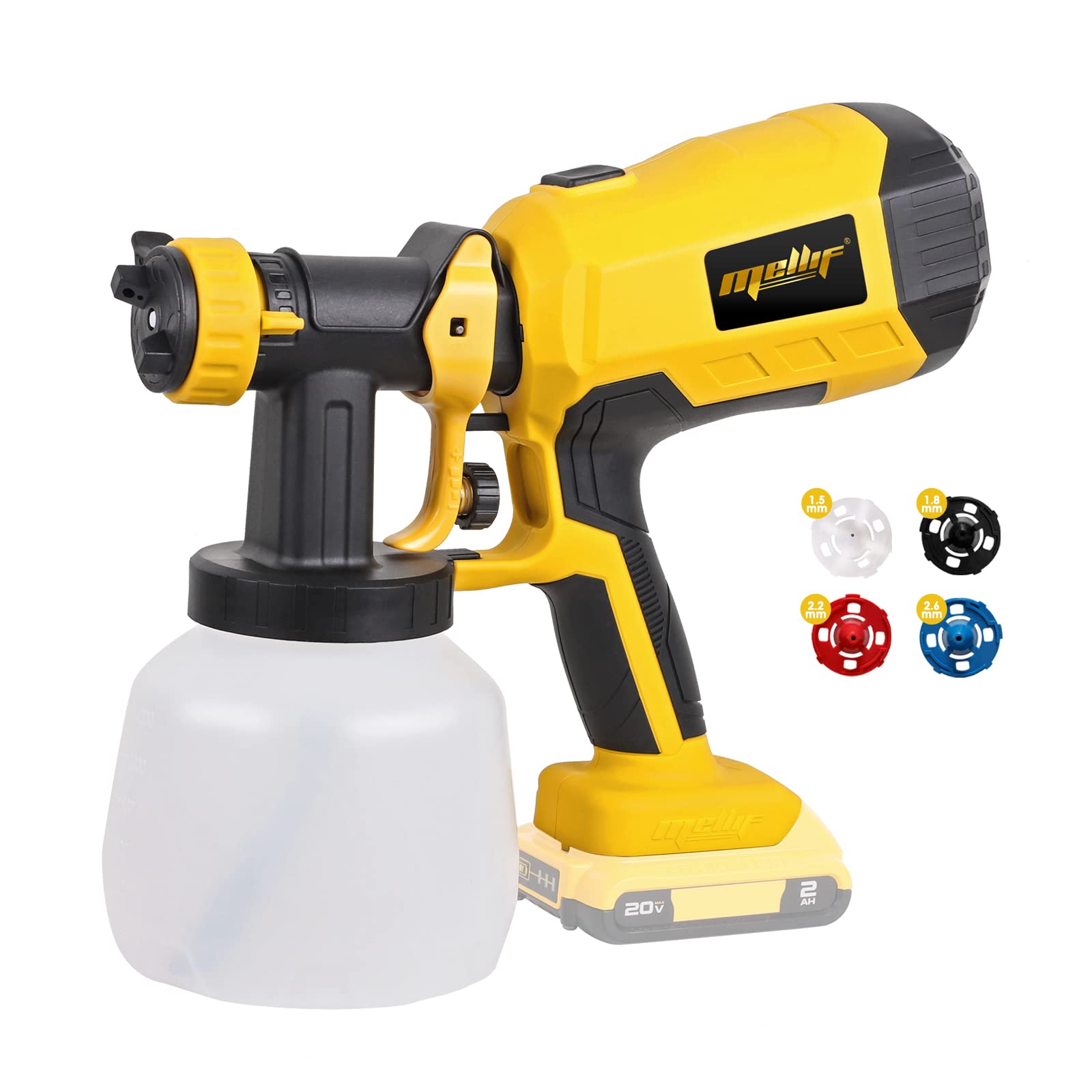
 Paint Sprayer Reviews & Buying Guides1 day ago
Paint Sprayer Reviews & Buying Guides1 day agoDEWALT 20V Cordless Paint Sprayer Review (2023)
-
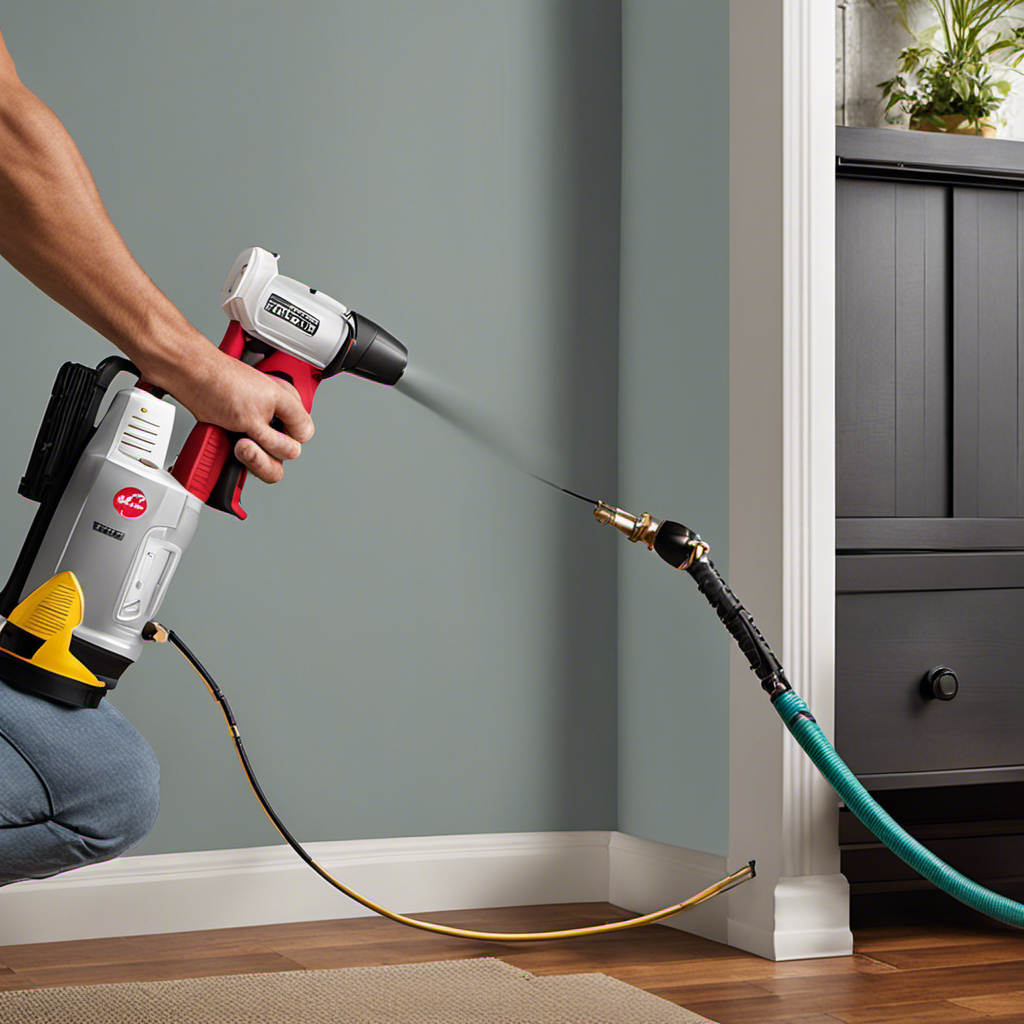
 Paint Sprayer Reviews & Buying Guides3 months ago
Paint Sprayer Reviews & Buying Guides3 months agoCalculating Paint Needs for Airless Sprayer: Coverage, Surfaces, and Tips (2023)
-
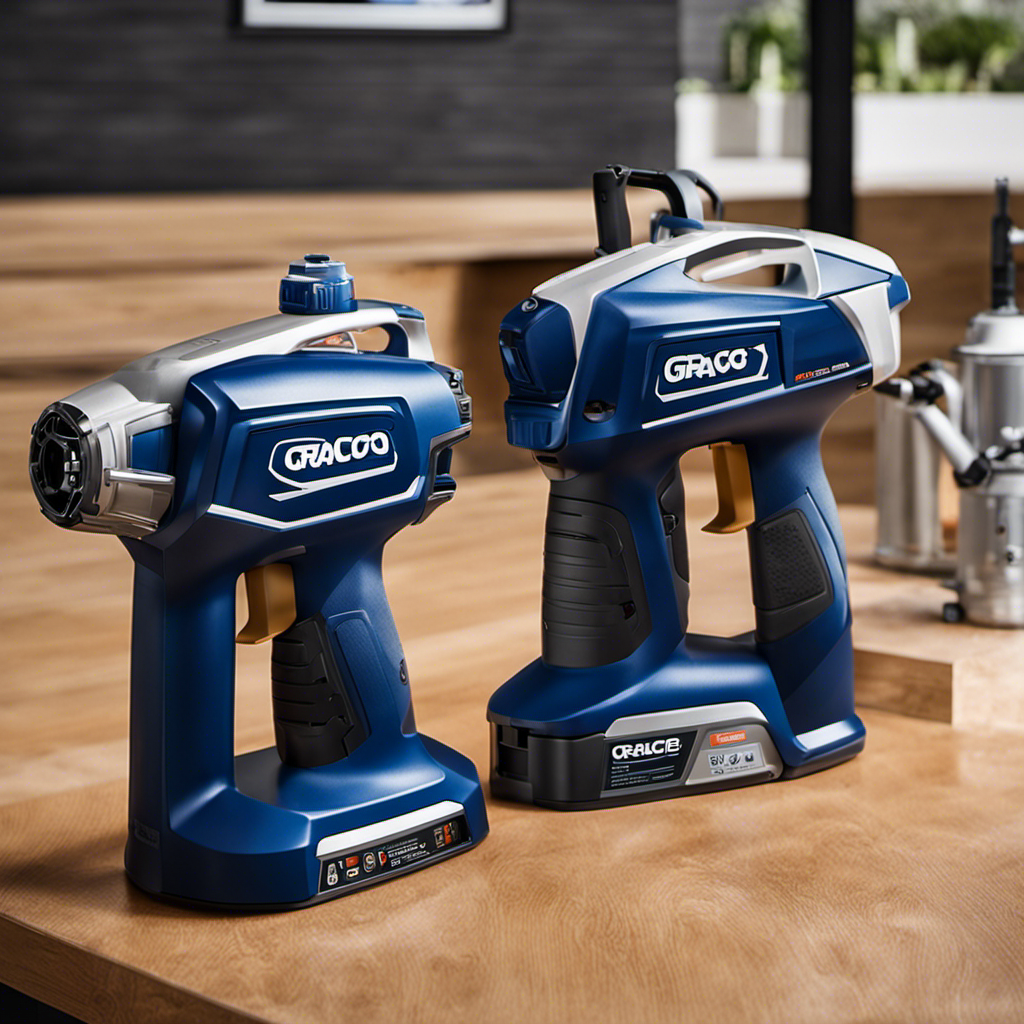
 Paint Sprayer Reviews & Buying Guides3 months ago
Paint Sprayer Reviews & Buying Guides3 months agoGraco Truecoat 360: DSP Vs VSP – a Comparison of Power and Portability (2023)
-

 How-To & Tips3 months ago
How-To & Tips3 months agoMastering the Avanti Airless Paint Sprayer: Tips and Techniques
-
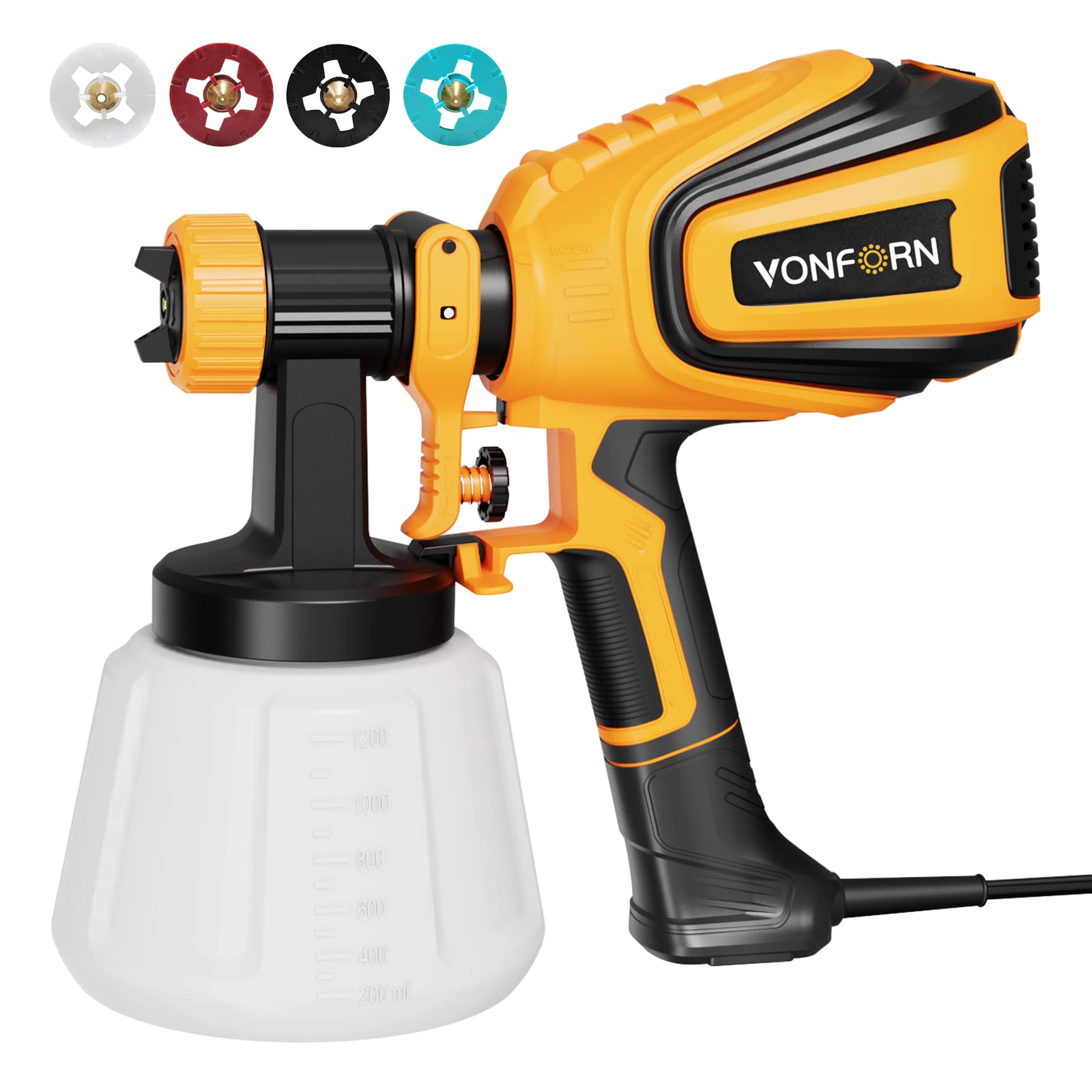
 Paint Sprayer Reviews & Buying Guides2 days ago
Paint Sprayer Reviews & Buying Guides2 days agoVONFORN Paint Sprayer Review: High Performance HVLP Spray Gun (2023)
-

 Paint Sprayer Reviews & Buying Guides1 week ago
Paint Sprayer Reviews & Buying Guides1 week agoSpray Painting Hazards: Safety Measures and Compliance (2023)
-
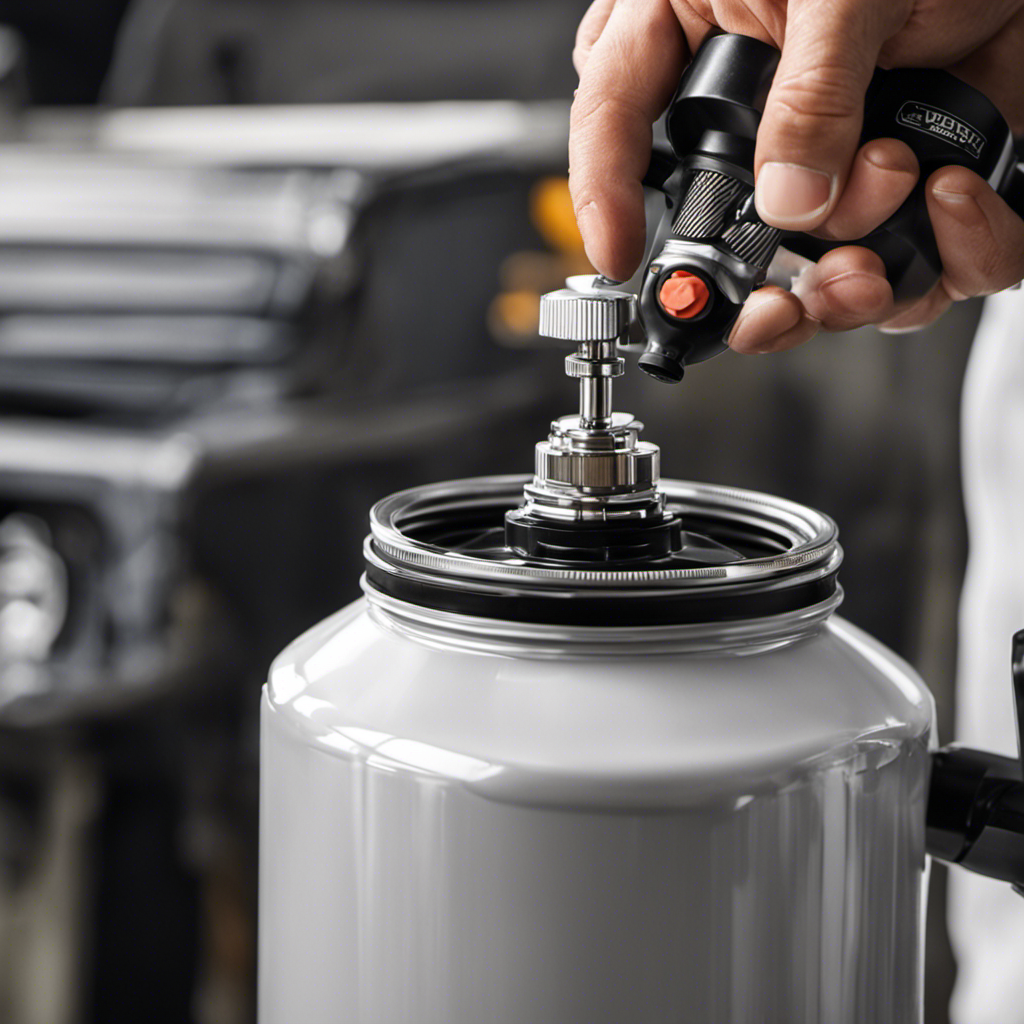
 Paint Sprayers FAQs3 days ago
Paint Sprayers FAQs3 days agoHow to Adjust Pressure on Airless Paint Sprayer
-

 Paint Sprayer Maintenance and Troubleshooting3 months ago
Paint Sprayer Maintenance and Troubleshooting3 months agoWhy Using the Right Oil Matters for Your Airless Paint Sprayer
